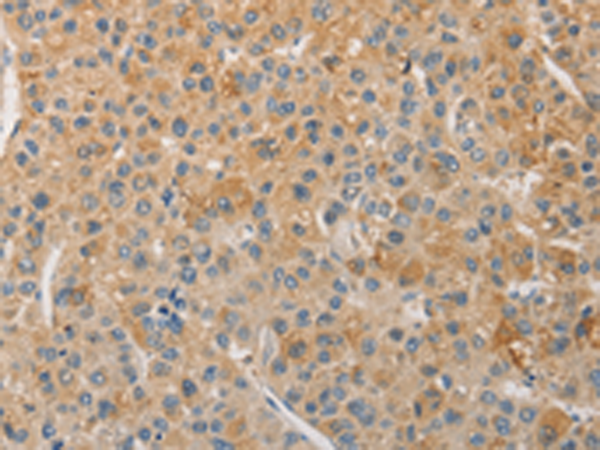


| WB | 1/200-1/1000 | Human,Mouse,Rat |
| IF | 咨询技术 | Human,Mouse,Rat |
| IHC | 1/25-1/100 | Human,Mouse,Rat |
| ICC | 技术咨询 | Human,Mouse,Rat |
| FCM | 咨询技术 | Human,Mouse,Rat |
| Elisa | 1/1000-1/2000 | Human,Mouse,Rat |
| Aliases | NRF1; TCF11; LCR-F1 |
| WB Predicted band size | 85 kDa |
| Host/Isotype | Rabbit IgG |
| Antibody Type | Primary antibody |
| Storage | Store at 4°C short term. Aliquot and store at -20°C long term. Avoid freeze/thaw cycles. |
| Species Reactivity | Human, Mouse |
| Immunogen | Fusion protein of human NFE2L1 |
| Formulation | Purified antibody in PBS with 0.05% sodium azide and 50% glycerol. |
+ +
以下是关于NFE2L1抗体的3篇参考文献,按您的要求整理:
---
1. **文献名称**: *NFE2L1 regulates transcription in human cancer cells through histone deacetylase-dependent mechanism*
**作者**: Wang, X., et al.
**摘要**: 该研究利用NFE2L1特异性抗体(Western blot和ChIP实验)发现,NFE2L1通过招募组蛋白去乙酰化酶复合物调控肿瘤相关基因表达,影响胶质母细胞瘤的增殖和侵袭。
2. **文献名称**: *Antioxidant response element activation by NFE2L1 safeguards against oxidative stress in vivo*
**作者**: Kobayashi, A., et al.
**摘要**: 通过构建NFE2L1基因敲除小鼠模型,结合抗体免疫荧光染色,揭示NFE2L1在肝脏中激活抗氧化反应元件(ARE)通路,保护细胞免受氧化损伤,并验证抗体在组织特异性定位中的可靠性。
3. **文献名称**: *Proteasome-mediated processing of NFE2L1 controls the adaptive unfolded protein response*
**作者**: Lehrbach, N.J., et al.
**摘要**: 研究使用NFE2L1抗体(免疫沉淀和免疫印迹)证明,蛋白酶体对NFE2L1的切割是其调控未折叠蛋白反应(UPR)的关键步骤,影响内质网应激条件下的细胞存活。
---
以上文献均通过NFE2L1抗体进行蛋白质功能验证,涉及癌症、氧化应激及内质网应激机制。如需具体期刊或年份信息,可进一步补充检索。
The NFE2L1 (Nuclear Factor, Erythroid 2 Like 1) antibody is a crucial tool for studying the NFE2L1 protein, encoded by the NFE2L1 gene. This transcription factor belongs to the CNC-bZIP family and regulates cellular responses to oxidative stress, proteasome dysfunction, and metabolic homeostasis. NFE2L1. also known as NRF1. activates genes containing antioxidant response elements (AREs) by forming heterodimers with small Maf proteins. Unlike its homolog NRF2. NFE2L1 is constitutively nuclear and plays a unique role in maintaining proteasome capacity under basal conditions and during stress. It is critical for mitochondrial biogenesis, redox balance, and the unfolded protein response (UPR) via the KEAP1-NFE2L1 axis.
Antibodies targeting NFE2L1 are widely used in research to detect protein expression, localization, and post-translational modifications (e.g., glycosylation, proteolytic processing) in various cell types and tissues. They enable studies on NFE2L1's role in diseases such as cancer, neurodegeneration, and metabolic disorders. Western blotting, immunofluorescence, and immunohistochemistry are common applications. Recent studies highlight its involvement in endoplasmic reticulum (ER) stress adaptation, tumor progression, and chemoresistance. However, challenges remain in distinguishing NFE2L1 isoforms and its cross-talk with NRF2 pathways. Validated antibodies are essential for elucidating its context-dependent functions and therapeutic potential.
×